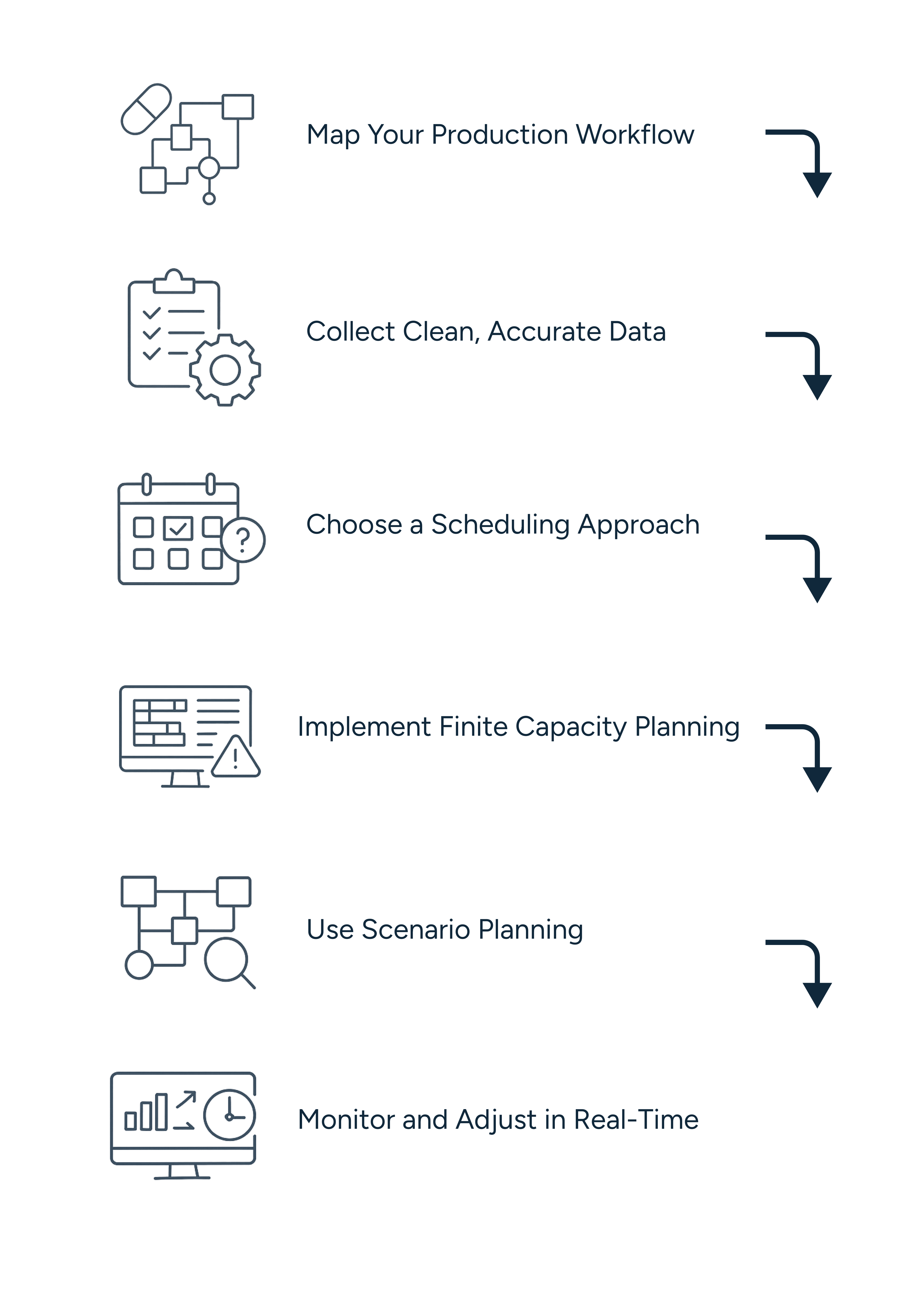Despite advances in digital systems, many manufacturers still wrestle with inefficient shop floor scheduling practices that cause delays, drive up costs, and threaten quality. According to Statista, 85% of manufacturers consider production planning and scheduling software crucial for their operations in 2024. Still, too many lack the tools or strategies to turn planning into a competitive advantage.
This guide explores how shop floor scheduling improves manufacturing efficiency, explains core concepts in plain English, and offers a step-by-step framework for implementing a more reliable and optimized production schedule.
What Is Shop Floor Scheduling?
Shop floor scheduling is the process of assigning work tasks to machines, equipment, and workers on the factory floor and determining the order and timing in which those tasks are executed. It’s like creating a real-time, resource-aware blueprint of “who does what, when, and how.”
Key elements of scheduling include:
-
Task assignment: Deciding which job or production order goes where.
-
Resource allocation: Assigning machines, operators, and materials.
-
Sequencing: Determining the order of operations.
-
Timing: Setting start and finish times for every activity.

A good schedule balances capacity, demand, and constraints to improve flow, reduce waste, and boost on-time delivery. It makes the best use of your production assets while staying responsive to changes.
Why Is Shop Floor Scheduling Important?
When done right, scheduling goes beyond logistics: it becomes a strategic lever for improving operational performance. Here’s how it boosts efficiency:
-
Maximizes asset use: Idle machines and underutilized teams are costly. Scheduling ensures equipment and labor are coordinated for optimal use.
-
Reduces bottlenecks: Thoughtful sequencing prevents work from piling up in one area while others sit idle.
-
Shortens lead times: Efficient schedules reduce delays, helping products move smoothly from raw materials to finished goods.
-
Minimizes rework and waste: Coordinated processes lower the risk of errors and reduce waste caused by bad timing or expired materials.
-
Improves delivery performance: On-time, in-full (OTIF) performance improves when production is predictable.
Supports quality and compliance: Scheduling validated equipment, trained staff, and required cleaning times is essential for maintaining regulatory standards.
The Core Concepts of Shop Floor Scheduling
Let’s break down the fundamental ideas you need to know to build a smart and scalable schedule:
1. Finite vs. Infinite Capacity Planning
-
Infinite capacity planning assumes unlimited resources and focuses on fulfilling demand regardless of constraints. It’s theoretical and often results in unrealistic expectations.
-
Finite capacity planning recognizes actual limitations in machines, labor, and time. It generates executable plans and reduces overcommitments. This is the gold standard for industries with strict resource requirements.
2. Backward and Forward Scheduling
-
Forward scheduling starts from a defined start date and calculates when jobs will be completed.
-
Backward scheduling starts from a due date and works backward to determine when production must begin.
These methods help planners balance available time and required output.
3. Work Orders and Routings
Each job on the floor is represented by a work order, detailing the product, quantity, and deadlines. The routing defines the step-by-step process that the product follows through the facility, including:
-
Setup and run times
-
Equipment and operator requirements
-
Transition times (cleaning, changeovers)
Understanding these elements ensures every job is scheduled based on realistic requirements.

What Makes an Effective Shop Floor Schedule?
A good schedule is more than a chart of tasks. It must be adaptable, realistic, and data-driven. Here are the building blocks:
Accurate, Granular Data
The foundation of any schedule is data. If your inputs are wrong, your outputs will be too. Essential data includes:
-
Bills of materials (BOMs)
-
Real-time machine and operator availability
-
Inventory levels
-
Planned maintenance and calibration
-
Order priorities
Real-Time Visibility
Scheduling isn’t static. Machines break down. Materials run late. Orders change. Real-time visibility helps planners respond quickly and keep production on track.
Key real-time data points:
-
Machine status (running, idle, down)
-
Work-in-progress status
-
Material availability
-
Quality holds and rework

Optimization Logic
Scheduling is about making trade-offs. Should you prioritize speed, cost, or delivery performance? Optimization algorithms help make those decisions based on defined goals.
Effective optimization helps:
-
Minimize changeovers
-
Balance workloads
-
Reduce setup times
-
Maximize campaign efficiency
Overcoming Common Scheduling Challenges
Even experienced manufacturers struggle with common barriers. Recognizing and addressing these is key to improving efficiency:
1. Manual Scheduling Methods
Relying on spreadsheets, whiteboards, or static ERP schedules limits visibility and scalability. It’s prone to human error and can’t adapt quickly.
Solution: Use software that automates and optimizes scheduling based on real-time data.
2. Disconnected Systems
If your production, inventory, and quality systems don’t talk to each other, you’re flying blind.
Solution: Integrate scheduling tools with ERP, MES, and quality management systems for synchronized planning.
3. Complexity and Constraints
Modern manufacturing is full of constraints: equipment validations, cleaning procedures, labor certifications, and expiry dates.
Solution: Use finite-capacity scheduling software that understands and accounts for these variables.
4. Inflexibility During Disruptions
Unplanned events like machine failure or raw material delays can derail production if your schedule can’t adapt.
Solution: Look for tools with built-in scenario planning or “what-if” capabilities to simulate options before committing.
Step-by-Step Guide to Better Scheduling
For when you’re ready to improve your floor scheduling:
Step 1: Map Your Production Workflow
Document every step, from raw materials to final packaging. Identify routings, resources, and dependencies.
Step 2: Collect Clean, Accurate Data
Audit your master data: machine capacities, setup times, labor skills, inventory, and downtime windows.
Step 3: Choose a Scheduling Approach
Select whether forward, backward, or mixed scheduling suits your business based on lead time requirements and production complexity.
Step 4: Implement Finite Capacity Planning
Use tools that respect your actual constraints—avoid overloading machines or assigning unavailable operators.
Step 5: Use Scenario Planning
Evaluate different schedule options to see the impact of decisions before finalizing a plan.
Step 6: Monitor and Adjust in Real-Time
Schedule adjustments should happen continuously. Integrate shop floor data to get alerts and optimize on the fly.

How PLAIO Solves Pharmaceutical Shop Floor Scheduling Problems
In the highly specialized and regulated pharmaceutical industry, these challenges are not just operational inconveniences; they are critical risks to patient safety, market access, and a company's financial health. This is where advanced planning and scheduling (APS) software, like PLAIO, fundamentally changes the game.
PLAIO is an AI-assisted decision support platform designed specifically to meet the unique and demanding complexities of pharmaceutical supply chain planning. While many systems offer general manufacturing solutions, PLAIO's capabilities are purpose-built to address the intricate requirements of pharma, providing a powerful and compliant answer to shop floor scheduling challenges:
Integrated Manufacturing Planning for Pharma
PLAIO’s approach seamlessly connects high-level Supply Planning with detailed Shop-Floor Planning. This ensures that strategic production goals are accurately translated into executable, compliant shop floor schedules. It holistically considers raw material availability, batch sizes, and the precise capacities of validated resources, ensuring a cohesive and achievable plan from end to end.
Precision Finite Capacity Scheduling
PLAIO rigorously applies finite capacity planning tailored for pharmaceutical assets. It accurately models the true capacity of your specialized machines, specific cleanrooms, validated production lines, and highly trained personnel. Crucially, it incorporates all relevant pharmaceutical constraints—cleaning cycles, sterilization times, calibration schedules, and regulatory hold points—preventing over-scheduling and creating truly realistic and compliant plans.

Intuitive Visual Planning
PLAIO's user interface is engineered for clarity, even with complex pharmaceutical workflows. Its visual planner provides an interactive, comprehensive overview of manufacturing stages and lines. Planners can easily understand intricate dependencies and make swift, compliant adjustments using drag-and-drop tools and color-coded visuals.
AI-Powered Optimization
PLAIO’s AI algorithms intelligently sequence production orders to minimize costly changeover times—a major drain on efficiency in pharma due to extensive cleaning and documentation. It supports optimal manufacturing campaigns by predicting capabilities and grouping batches based on regulatory requirements, material expiry, and resource qualifications.
Real-Time Data and Decision Support
PLAIO integrates with ERP, MES, and quality systems to pull live data from the shop floor. If a machine goes down or materials are delayed, PLAIO updates the schedule instantly, shows the impact, and recommends compliant adjustments. This allows planners to act proactively, not reactively.
Compliance and Audit-Readiness
Every decision and change is logged and traceable. PLAIO supports GMP compliance by ensuring qualified resources are scheduled appropriately and providing a clear audit trail of scheduling activities for regulatory inspections.
From Chaos to Clarity
Whether you're working in pharmaceuticals or any other complex manufacturing environment, mastering shop floor scheduling means better resource use, lower costs, faster delivery, and ultimately, a more resilient and competitive operation.
Explore how PLAIO can help move from static spreadsheets to intelligent, adaptive shop floor scheduling designed for the real world with our Pharmaceutical Supply Chain Planning Software.